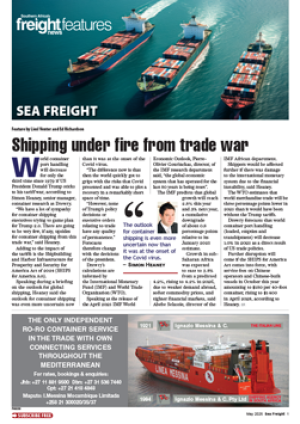Study will compare costs and efficiencies with Durban
JOY ORLEK
THE AUTOMOTIVE Industry Development Centre (AIDC) will put the Port of Maputo’s cost and efficiency claims to the test when it undertakes a two port comparison to assess the most cost-effective option for Gauteng shippers The study is expected to move into action in March/April next year and will compare Maputo with the Port of Durban. This will run along similar lines to the AIDC’s May 2005 study comparing Walvis Bay, Durban and Port Elizabeth in terms of lead-time, warehouse-to-port transit time, port-to-port transit time, total transit time and total cost comparison. The 2005 report revealed that while port charges in Walvis Bay were the cheapest, the higher road transport cost to the port was a limiting factor. In the case of Maputo, landside logistics will be an important element, says AIDC project manager, Hannelie Viljoen. “We will therefore look carefully at landside logistics and lead times as well as seafreight logistics and lead times. Because Maputo is the closest port to Gauteng, if the landside logistics costs are low enough, Maputo might become a feasible option for the automotive industry.” Coming two years after the last comparative exercise, the results of the 2007 comparison are expected also to provide valuable feedback on Durban’s changes in productivity two years down the line. The AIDC is interested in Maputo for several reasons, says Viljoen. “South African ports are congested, and that is a concern for us. “We believe Maputo can complement South African ports and alleviate some of the pressure. The close proximity to Gauteng OEMs (Original Equipment Manufacturers) and the potential to function as the gateway to the Far East based on transit times and supply chain costs are important factors. “From a private port point of view it offers the potential for volume-based rates. Other socio-economic opportunities lie in the regional development especially of NEPAD countries.” An automotive industry fact-finding tour of Maputo was undertaken in 2004 to assess the viability of the corridor as an additional transport route. Its potential was recognised but the landside logistics and infrastructure were a concern. “Road and rail infrastructure needs to be in place for it to become an attractive option for the automotive industry,” says Viljoen. “We are currently talking to Gauteng exporters who are interested in Maputo. The results of the comparative study will be benchmarked against the South African corridor. This will give us a feel for the benefits that the Maputo Corridor could add to the automotive industry. ”
Automotive industry to test-drive Maputo corridor
03 Nov 2006 - by Staff reporter
0 Comments
FTW - 3 Nov 06
03 Nov 2006
03 Nov 2006
03 Nov 2006
03 Nov 2006
03 Nov 2006
03 Nov 2006
03 Nov 2006
03 Nov 2006
Border Beat
Featured Jobs
New
New
New
